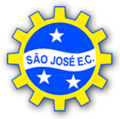São José Esporte Clube
 | ||||
| Full name | São José Esporte Clube | |||
|---|---|---|---|---|
| Nickname(s) | Águia do Vale (Eagle of the Valley) | |||
| Founded | August 13, 1933 | |||
| Stadium |
Martins Pereira, São José dos Campos, Brazil | |||
| Capacity | 15,317[1] | |||
| President | Hélio Fontes | |||
|
| ||||
São José Esporte Clube, usually called São José, and nicknamed Eagle of the Valley (Águia do Vale), is the main football team in São José dos Campos, Brazil. Its home stadium is Estádio Martins Pereira, which has a maximum capacity of approximately 15,300.
History
The club was founded on August 13, 1933, as Esporte Clube São José, after Futebol Clube and Klaxon merged.[2] The club merged in 1945 with Associação Esportiva São José to form São José Esporte Clube.[2]
On March 8, 1964, São José became a professional club.
In December, 1976, due to a financial crisis, the club changed its name to São José Esporte Clube, with the purpose of not paying its debts. The club also changed its colors, which were black and white, to the current blue, yellow and white ones, and changed its logo.
In 1989, the club was runner-up of Campeonato Paulista, after beating Corinthians in the semifinals, and losing to São Paulo in the final,[2] and runner-up of Campeonato Brasileiro Second Division, losing to Bragantino in the final, but being promoted to the following year's first division.
In 1996, São José won the Copa Vale after defeating Aparecida in the final.
In 2003, the club was renamed to Esporte São José, but in 2005, the club returned to its previous name, São José Esporte Clube.[3] In 2006, São José moved back to Campeonato Paulista A-2.
Years in Campeonato Brasileiro Série A:
1982 Place: 12th out of 44
1990 Place: 19th out of 20
Achievements
- Campeonato Paulista Third Division: 1
- 1965
- Campeonato Paulista Fourth Division: 1
- 1964
- 1972, 1980
- Campeonato Paulista Special Division: 1
- 1987
- Campeonato Paulista First Division: 0
- Runner-up (1): 1989
- Runner-up (1): 1989
- Copa Vale: 1
- 1996
- Campeonato Paulista A-3: 0
- Runner-up (1): 2006
Notable players
 Émerson Leão
Émerson Leão- Fidelis
 Roque Junior
Roque Junior- Sérgio Valentim
- Tião Marino
Stadium
São José's home pitch is Estádio Martins Pereira,[4] inaugurated in 1970, with a maximum capacity of 15,317 people.[1] On March 22, 1970, São José Esporte Clube played its first match in Estádio Martins Pereira. São José and Nacional (SP) drew 0-0.
Mascot
The Águia (Eagle) became the official mascot of São José in 1978, two years after São José changed their team colors. "Azulão do Vale" (Big Blue of the Valley) was the team's nickname before that, but they changed it to "Águia do Vale" when Águia became the team's mascot. Águia was chosen as the club mascot as eagles are driven animals and will fight to the end even against the odds.
Rivalry
The biggest rival of São José is Taubaté. The derby between the two clubs is known as O Clássico do Vale do Paraíba (The Paraíba Valley Classic).
The team that São José played most against is Santo André.
Kits
The current kits of São José are made by Umbro. Until December 1976, the club played in black and white vertical striped shirts, black shorts and white socks, not unlike Corinthians away kit.
Important matches
Finals of Campeonato Paulista A-1 1989
- June 28 - São José 0-1 São Paulo
- July 2 - São José 0-0 São Paulo
(Both games were in Morumbi in São Paulo)
Tour of Spain 1989
- August 17 - São José 2-1 Torrevieja
- August 19 - São José 1-1 Palamós
- August 21 - São José 0-0 Córdoba
- August 22 - São José 0-0 Martos
- August 24 - São José 2-1 Réus Desportivo
- August 25 - São José 1-0 Atlético Palma
- August 27 - São José 3-1 Mollerussa
- August 28 - São José 0-0 Estepona
- August 29 - São José 2-1 Portullano
See also
References
- 1 2 "CNEF - Cadastro Nacional de Estádios de Futebol" (PDF) (in Portuguese). Confederação Brasileira de Futebol. Retrieved November 27, 2011.
- 1 2 3 Lancepédia - A Enciclopédia do Futebol Brasileiro (in Portuguese). 1. Rio de Janeiro: Lance! Publicações. August 2009. p. 257. ISBN 978-85-88651-14-2.
- ↑ "São José Esporte Clube" (in Portuguese). Arquivo de Clubes. Retrieved November 29, 2011.
- ↑ Rodolfo Rodrigues (2009). Escudos dos Times do Mundo Inteiro. Panda Books. p. 91.